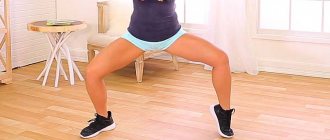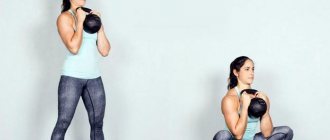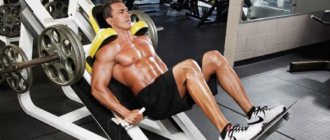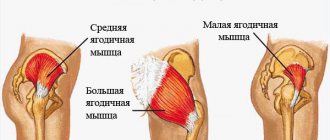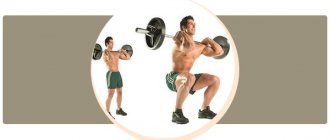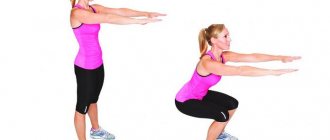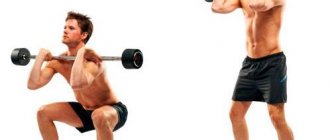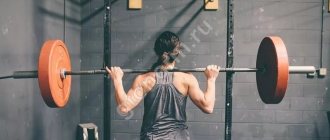Classic squats without weights in the CrossFit world are called air squats. This exercise can be called one of the most common in the world, and not a single sport can do without it.
It has a number of important properties that explain its popularity. Such squats are useful not only for their effect on the muscles - they are also a great way to improve blood flow in the body. They can be performed anywhere and are suitable for athletes of all skill levels.
What do air squats do?
The main purpose of air squats in CrossFit is to prepare for proper and safe squats with a barbell.
Benefit
- Endurance is trained, which is so important for improving physical performance in sports. The functioning of the cardiovascular system improves.
- The entire lower part of the body is well worked out: the muscles of the buttocks, the inner and front surfaces of the thighs, the biceps of the thighs, as well as the posterior muscles of the lower leg. For all these muscles to work effectively, it is necessary to follow the correct technique for performing the exercise, which will be discussed a little later.
- The training promotes fat burning, because... refers to high-intensity physical activity.
- Prevention of diseases of the joints and musculoskeletal system. Improves joint flexibility, which is necessary to avoid injury when performing weighted squats.
- Squats develop balance and coordination, especially with high repetitions.
And another important advantage of air squats is that you can perform them anywhere: in the gym, at home and even at work.
Harm
Despite the many benefits, air squats can also cause harm. And the very first thing you need to pay attention to is the knee joints, which take on a serious load during squats. Therefore, you should not overpower yourself and perform squats for people who have:
- diseases of the knee joints and experiencing discomfort when performing exercises;
- excess weight, which can negatively affect joints during squats.
Also, air squats can be harmful if you have problems with the spinal column or heart disease. In both cases, the exercise must be done very carefully, monitoring your well-being. A healthy spine and heart are more important than toned legs.
To avoid injury, before performing the exercise, it is necessary to stretch the tendons and joints well: they must be well warmed up.
MEN VS WOMEN
Well, how can you squat anyway, if it’s good this way and that way, and it’s possible this way and that way.
FOR GIRLS:
- We sit down as deep as possible, by moving the pelvis back, and not by bending the knees.
- Your knees do not go beyond your toes))) and in order to squat as low as possible in this position, you need to tilt your body forward. BUT your back is always straight!!! It is allowed to tilt up to 45 degrees, but I wouldn’t go further than 30, try to keep your back as straight as possible, and bend only to pull your buttocks back if necessary. The more vertical your back is, the more your knees will move forward and vice versa, the stronger the back tilt, the closer your shins are to the vertical, i.e. less acute angle.
- Your main focus is on the glutes and lower thigh stretches. Only the pelvic-dominant style is suitable for you, when the knees are fixed and the pelvis rotates around them.
- Weight is practically irrelevant. Only the force of tension and stretching of the muscles.
WOMEN'S VERSION OF SQUATS:
FOR BOYS:
- We sit down to the CORRECT parallel. Knees and upper thighs in one line.
- We keep our back as vertical as possible, this creates maximum load on the front surface of the thigh. Which style you choose is your decision.
MEN'S VERSION OF SQUATS:
How do I do it? Like a damn half-girl))) I squat as low as the stretch allows, with the pelvis abducted, but I keep my body vertical, this is a lifter’s style.
Causes:
- I don't have time, like professionals, to divide workouts into different muscle groups, so I try to cover as much as possible. The lower the squat, the more muscles are worked, which allows me to avoid focusing on the hamstrings.
- Knees!!! I knocked out my wrists in boxing, injured my elbows in arm wrestling, my knees have been working in harsh conditions for 17 years now, and no problems, although for many they begin to “crunch” even without load. This is because in modern life there is no load on the biceps and adductors, this creates an imbalance and subsequent problems.
And not a big remark. What is the most UNSTABLE position of the knee joint? When the angle is 90 degrees. That's why honey. examinations, you are asked to sit in a chair before your knee is examined, i.e. he is diagnosed in his most vulnerable state.
If you squat TO PARALLEL, then the knee angle will be 90 degrees, you take more weight than for a deep squat, which means the load on the knee is greater and the biceps muscles of the back surface do not balance the squat. We get the fastest way to twist our knees like a grasshopper =)
3. Back injuries - the smaller the amplitude, the more weight we can lift, and I have already grown beyond the age at which I want to measure my pussy, I am interested in the maximum development of the body, and not in records, so my modest 150 kg will always be for me top bar.
4. There is no problem getting a fat ass from deep squats, because... it depends on the amount of fat in the body, so whether men should be afraid of this or not, everyone decides individually:
I won’t show my ass for clarity, we are family. They will leave you without borscht.
Air squat technique
The most important thing to pay attention to when performing the exercise is the correct positioning of the body and legs. To perform the exercise correctly, you must follow the sequence:
| We take the starting position | Place your feet shoulder-width apart or slightly wider. We check the correct position of the feet and body: the toes and knees should be in the same plane, the back should be straight with a natural arch in the lower back. We spread our arms to the sides or hold them straight in front of us - this will help maintain balance. We direct our gaze straight ahead. |
| Doing a squat | As you exhale, lower yourself until your thighs reach parallel to the floor. You can go lower, but your back should remain straight. |
| Returning to the starting position | Having fixed at the bottom point for a couple of seconds, we rise to the starting position. |
We perform the exercise the required number of times, then a short rest and a new circle. Three approaches are optimal. Let it be 20 times, but three approaches.
Technique alone is not enough to perform the exercise. It is also important to consider a number of key points:
- When performing squats, your feet should be firmly fixed on the floor. This is necessary for proper distribution of body weight and improved balance. This technique will be very useful in the future when working with weights.
- Strictly monitor the movement of your knees. If your feet are pointing forward, then your knees should be pointing forward in squats. Another variation of the exercise is possible, in which the feet are directed to the sides. Accordingly, the knees in this case should also be directed to the side throughout the entire element.
- The back throughout the entire exercise should be strictly straight with a natural arch in the lower back. Under no circumstances should you round your back. This can lead to serious problems with the spine. It is better to “undersquat” than to round your back.
- Your arms shouldn't just dangle. Forward or to the sides - this is their main position.
- The head should not be lowered - look straight ahead.
- Body weight should be distributed evenly on each leg. When reaching the bottom point, the support on your feet should be in the middle between your heels and toes. This will protect you from hip injuries and damage to the knee joints. This is especially true when working with scales.
Basic mistakes
Beginners inevitably make mistakes when performing air squats. These may seem like small things, but since air squats largely serve as preparation for performing more complex squats, especially with weights, it is necessary to understand what these mistakes are and how to get rid of them.
- The legs are spaced too wide or, conversely, too narrow. The main criterion here is convenience and stability.
- The direction of the feet and knees does not match.
- The head is tilted, the gaze is directed to the floor or to the side.
- Incorrect position of the arms: they should not be dangled or swung, they should help maintain balance.
- The back is rounded, there is no arch in the lower back.
- Squats not deep enough.
- Sometimes athletes use the quadriceps femoris muscle to squat. As a result, it is not so much the pelvis that is extended, but rather the legs, which does not at all meet the goals of the exercise.
How often should you do air squats?
You can start with 15-20 squats in one approach. There should be at least three such approaches in total. Gradually the number of repetitions can be increased to 35 times.
In air squats, the main thing is not quantity, but quality.
If you do fifty shallow squats, you won’t get the desired effect. It’s better to do it 20 times, but of high quality, in compliance with all requirements.
The good thing about air squats is that they can be performed by both professional and amateur athletes. Moreover, everyone’s goals may be different. If the first one practices the technique for further work with the barbell, then the second one squats simply to keep himself in shape.
Where to begin
Many women dream of having beautiful, firm buttocks.
First of all, they are boring in order to attract the attention of men, and only then to amuse their pride. Some people diligently take up sports, buying a subscription to a fitness room, some watch training videos, try to train at home, while for others, their desire remains unfulfilled.
It all depends on character and willpower.
Therefore, in order to start exercising, you need to know a few rules that will help you successfully achieve success:
- keep your abs in constant tension;
- the back should be straight;
- the knees should be parallel to the feet (otherwise there will be a crunch in the knee);
- do not lift your heels off the floor;
- correct breathing.
You may ask: why keep your abs in constant tension if you need to pump up your buttocks? The answer is very simple. When the abs tense, the whole body tenses. Such physical composure helps maintain the shape of not only the gluteal muscle, but also the abdominal muscles, and this is an additional success (abs training program). But this rule must be followed, otherwise you will not achieve the necessary progress.
The second, important rule is to keep your back straight. In this case, the tension goes to the back muscle
This makes the butt round and convex, the back straighter (How to correct posture), more beautiful. With a straight back, squats are more difficult, so the results will be more noticeable. If your back is bent, the training is carried out easily and quickly, then you will not achieve the desired effect. After all, it will be more like tilting rather than lowering.
As for the legs, they should be shoulder-width apart. Knees parallel to feet. At this angle it is better to tense the gluteal muscles. It also tightens your legs, eliminating cellulite. This position of the legs has a positive effect on the entire lower body.
Feet should not leave the floor. This position of the feet has a good effect on the calf and gluteal ligaments. It also covers the entire lower part of the body, bringing it into order. When you lift your feet off the floor, the desired effect does not occur. The tension does not reach the buttock, and therefore does not affect the result in any way.
And proper breathing is the basis of any exercise. Taking a deep breath while lifting and exhaling while squatting will make your exercise a little easier. Most often, people run out of breath precisely because of improper breathing. Even the most resilient people must use proper breathing techniques. It will help you conserve energy and perform exercises calmly.
To perform lowering correctly, you should follow the rules. Then in a short period of time, you will see at least a small result. And to see the result, you will have to work hard for a couple of months. This is not much compared to how happy you will be with the result. But it is worth remembering that you should exercise regularly to achieve the desired effect.
It is important to know that in order for your butt not to disappear after two weeks, you need to visit the gym at least twice a week. This is necessary to maintain existing forms
